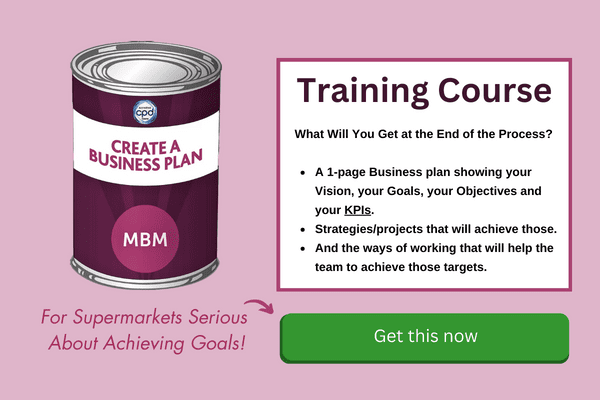How you can take the Brave Approach to Writing a Joint Business Plan – JBP – with a UK Supermarket:
Writing a Joint Business Plan (JBP), creating Joint Business plans, JBPs, or terms negotiations, as they can be known, are all relatively new phenomena in the world of supermarkets and suppliers. Whilst some supermarkets and suppliers, particularly the brands, have talked about joint business planning for some time, it is only in the last few years that it has become ‘business as usual’. Now featured in industry news and some Joint Business Plans are published online – This JBP is for Tesco and Nestle in Poland.
The first moves towards a JBP were made when Category Management and ECR made an appearance in the 1990s with tools like the Category Scorecard. Hard-nosed buyers and sceptical account managers reluctantly dipped their toes in the water of true collaboration. Though, as Stephen Covey writes in Habit 4 win:win, the only way forward is together for mutual benefit. The definition of joint business planning is to work with a collaborative mindset towards mutual goals agreed upon for the benefit of the supermarket, supplier and shopper.
The Brave Approach to Writing a Joint Business Plan with a UK Supermarket is about helping UK supermarket suppliers to identify their true business objectives. Also, to understand what is strategic planning, identify the business terms and create a business plan that is worth having for both parties. Here are 7 brave moves that should be taken in The Brave Approach to Writing a Joint Business Plan with a UK Supermarket. This is because a supplier that does, will be best in class:
1. Stating the Blindingly Obvious – A Joint Business Plan is All About Trust
In Accenture’s free report on joint business planning, they talk of a change in mindset for both parties to achieve ‘Increased trust among parties’. And, of course, Accenture is right that trust is absolutely essential for a joint business plan to be effective. Plus, the IGD industry survey on Category Management Capability and Partnership of 2014, said that ‘Too often trust is the biggest barrier to putting any proposal into action’.
The challenge is that trust is hard to build and even harder to understand, particularly for people representing two large companies, where the aim is to make as much money as you can, usually by giving the other party less.
Discussing trust can be a sensitive topic and a brave topic to raise. Doing so provides a solid foundation to build upon. The simple choice is to either raise these issues now or to become frustrated when nothing happens. Better now because both parties are wanting to build a future together.
Action: Add ‘Building further trust’ as an early agenda point in your joint business planning meeting.

2. KISS is the Route that Succeeds Most with Joint Business Plans

KISS is a mnemonic that is often said and rarely used. In joint business planning the watch out is not to write a joint business plan together where people spend days locked away in darkened rooms solving the vision, the big category problems, discussing shopper switching, the next range review, why promotions don’t work, and the ‘kitchen sink’. The challenge and the brave approach is to work on less to achieve more.
Scoping what both parties want to achieve is essential and then identifying the 80:20 of those items. The objectives will be easily identified and usually around, ‘To write a joint business plan that delivers x growth/market share/sales by <date>’. The scope is hard. The important part because it might be just to complete a simple one-page document showing:
- Category Targets
- Category Measures
- Enabling Big Projects
- Project Milestones
- Ways of Working
This document could be just one page. But it is a bought-in, thrashed and motivating page. A page that both parties agree to start with and then review in 3 months. An 18-month plan is about the right timescale to tackle a joint business plan. There are those that will advocate 3 years and even 5-year business plans are needed. The challenge is that most supermarket buyers will not be in place beyond 18 months, and many account managers too.
Action: Agree on the scope of the joint business plan. Divide a page into two, headed up with the scope and then 2 columns; In and Out. Agree on what is in scope, e.g. Discussions that are big picture and what is out of scope, e.g. The day-to-day detail.

3. Naming the Big Project Outcomes is the Key to Success
In our Time Management Training course we talk with the learners about the importance of having a project list and describe the daily to-do list as the wheels of a car, and the project list as the steering wheel. Those without a project list fail to steer towards their KPIs and KRAs, preferring to work on the day-to-day, refusing to acknowledge the big stuff and claiming that they are ‘too busy’.
The same is true of joint business plans and the key is to define the outcome. Instead of writing ‘Promotions Project’, change it to a project outcome title, which could be ‘Promotions Adding Sales of £5m p.a.’. Whilst a subtle change, the difference is that if no traction is made the impact is obvious – £5m lost. Plus, it is less likely that the person will remove the project when the outcome is obvious, and the project owner can genuinely begin with the end in mind – £5m sales to identify.
Making traction on the big projects is essential to see early progress on joint business planning. For each big project, the collaborators need to agree on the first 3 practical and simple actions. These 3 actions will get the project moving. Even if those actions are to get together for 1 hour to brainstorm. Maybe brainstorm how to achieve £5m additional sales from promotions. It is imperative that these debates are not tackled at the Business Planning meeting. This is because it is ‘scope creep’. Which means that it is against the scope that was agreed. Plus, the meeting will achieve very little because too much is trying to be achieved.
Action: Change project titles to project outcomes and agree on the first 3 practical and simple steps for each project.
Sticky Learning ® is 7 times more effective than 1-day training courses. Plus, you will get a Chain of Evidence proving your Return on Investment. Discover soft skills training that changes behaviours long term.

4. A Simple Dashboard Every 2 Weeks to Keep Things Moving
The experience of most people is that business plans are built with love and sit on a shelf with hate. Their examples have taught them that joint business planning is a necessary evil and ultimately achieves very little.
The brave move is to change your mindset. Get out of the self-fulfilling prophecy, by doing Joint Business Plans differently to the last 10 times. Helping to achieve that is a simple dashboard showing the Category Targets, Category Measures, Enabling Big Projects, Project Milestones, & Ways of Working and most importantly, the progress, with a short commentary. Ideally, on one page, the dashboard is published every 2 weeks. Fortnightly because 1 week is not long enough to see progress and one month is too long if progress is going off-course.

By having a dashboard the joint business plan is kept alive.
Action: Propose a simple dashboard that is to be published every 2 weeks, for the group to approve.
5. Reviewing the Joint Business Plan Quarterly Together
A smaller team is a brave move. This is because, during the landing of Category Management and ECR in the 90s, the supermarket team and the supplier team would be around 12 people each.
Whilst this was more a demonstration of collaboration and ‘equalling the fight’ than anything else, progress was slow. Nowadays a smaller team can achieve more if they accept that their accountability is to get the information, persuade the other departments, and basically make progress, not being able to cite every other department in their company as the reason for not achieving the required progress.
A smaller team should meet every quarter with the only point on the agenda to discuss the joint business plan. These dates need to be diarised for the full 18 months. Again, the scope is important because the temptation will be to discuss the other 100 issues that need addressing. But bravely accepting that the joint business plan, if delivered, will achieve everyone’s goals, then this is the only topic of discussion.
Beginning with a refresh of what the joint business plan looks like, the agenda should look like this:
- Refresh the joint business plan.
- Ways of Working – Have these been adhered to? What else needs to be done?
- Performance Vs the agreed targets.
- Project progress Vs the agreed milestones.
- Discuss the usefulness of the dashboard, not being tempted to make it too onerous.
- Run through the actions stating what, who and when very clearly and emailed before everyone leaves. Our top tip is to capture actions on email as the meeting progresses. Not afterwards because each one is likely to be re-debated.
- Agree on the date of the next meeting.
Action: Propose dates for the next 18 months and a suggested agenda.
6. Strategic Thinking is the Essential Skill
In the most recent IGD trading survey both suppliers and supermarkets ranked ‘strategic alignment’ and ‘long term planning’ as important now and even more important in the future. The supermarkets said that having these skills was what a supermarket would expect from a ‘best in class’ supplier.
Strategic Thinking, as well as being one of those overly used terms and mystifying skills, has now become essential to joint business planning. So much so that job advertisements are asking for applicants to have joint business planning experience. Strategic thinking, strategic planning, and having strategic objectives are about being able to see the big picture, identify insights with high impact and make them happen. The skills of joint business planning are the same, as well as an effective use of some negotiation skills.

The brave move would be to initiate a joint business plan with the supermarket and begin to implement this roadmap to category growth.
Action: Read this post on strategic thinking and consider an executive coach to prepare you for your next JBP so that you are the best version of yourself when you negotiate, share your big-picture thoughts and discuss trust.
7. These Critical Meetings are ‘Must Win Meetings’ for Any Supermarket Supplier
Initiating, or being invited to a Joint Business Plan meeting, is pivotal to every supplier because, of course, terms are negotiated and the outcome will have a high impact on the supplier’s annual performance, but also a Joint Business Plan meeting is an opportunity to demonstrate ‘best in class’. Best in class for category understanding, shopper understanding, supermarket understanding, possible solutions, and how to manage these plans to make them work.
For these reasons, the preparation for a must-win meeting must be to achieve the old adage of ‘sweat in training, no need to bleed in battle’.
Role plays are an undervalued tool for preparing and for getting the heads-up on those things that could not be predicted and are yet to happen. When millions of pounds can be at stake for one meeting, it pays to be prepared, and ask the experts for help to be the very best version possible.
Action: Book a role play with a suitable colleague/s so that you can sweat in training, or contact us for help. See our Fyffes testimonial for how we supported them.
A Summary of the 7 Brave Moves
Here is a summary of the 7 brave moves that should be taken in The Brave Approach to Writing a Joint Business Plan with a UK Supermarket because a supplier that does, will be best in class:
- Stating the blindingly obvious – It’s all about trust.
- KISS is the route that succeeds most with joint business plans.
- Naming the Big Project Outcomes is the Key to Success.
- A Simple Dashboard Every 2 Weeks to Keep Things Moving.
- Reviewing the Joint Business Plan Quarterly Together.
- Strategic Thinking is the Essential Skill.
- JBP Meetings are ‘Must Win Meetings’ for Any Supermarket Supplier.
What is your top tip for writing a JBP? Please share your view by commenting at the end of this article.
Creating a JBP that Includes the Required Elements of the Groceries Code Adjudicator
Only 1 in 2 Suppliers has a written supply agreement according to research by the Groceries Code Adjudicator (Slide 16). A written supply agreement is often a joint business plan. Therefore here is a checklist of often-forgotten items that should form part of the written supply agreement/JBP:
- Payment terms
- Marketing costs, e.g. artwork, packaging, consumer research, or hospitality
- Payments for wastage




